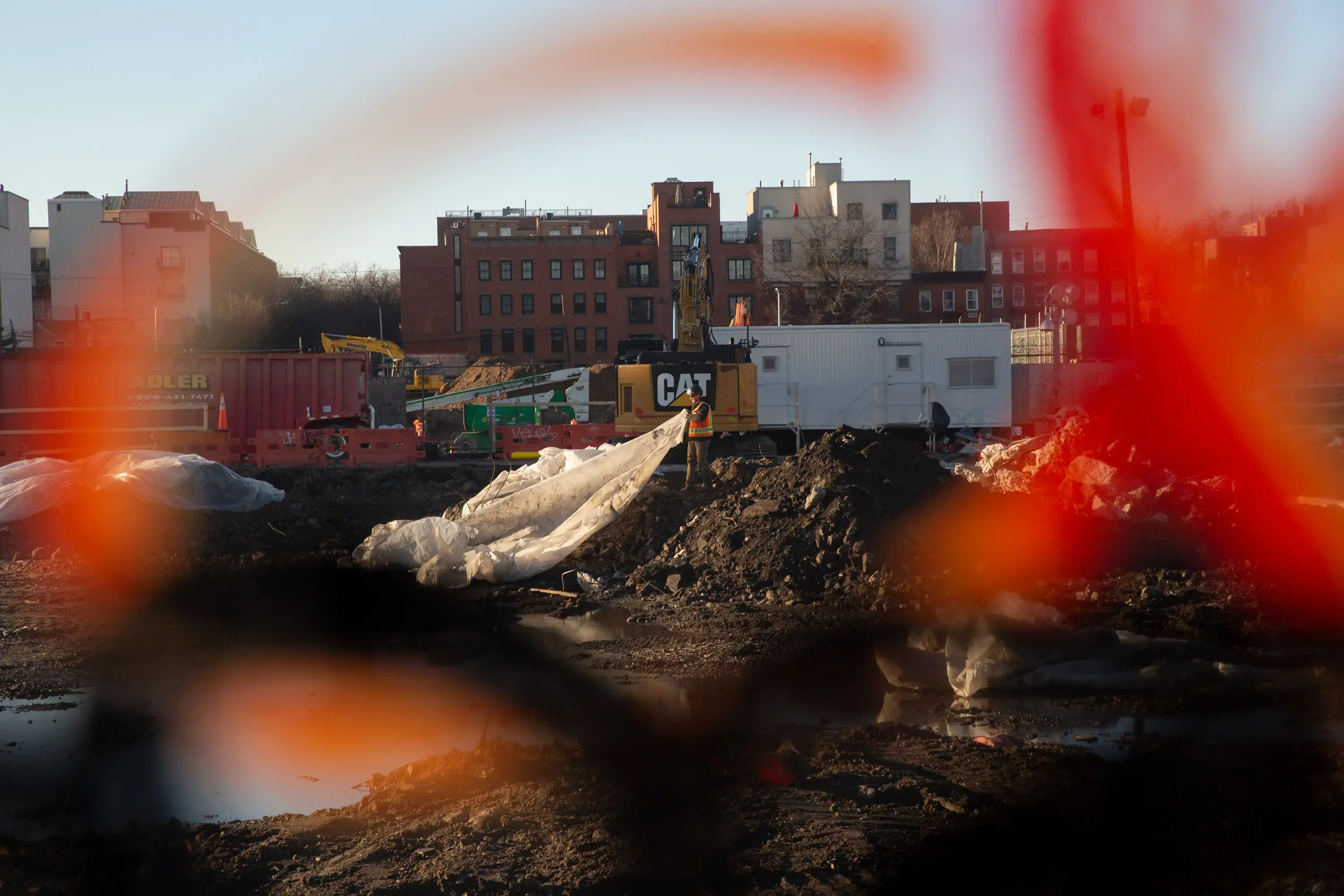
A fast-growing Brooklyn neighborhood deals with the legacy of industrial contamination, ongoing sewage spills, and frequent flooding — all made worse by climate change.
Hazard NYC was made possible by support from the Fund for Investigative Journalism. The project was produced in partnership with the McGraw Center for Business Journalism at the CUNY Graduate School of Journalism, and is part of the Pulitzer Center's Connected Coastlines initiative. Hazard NYC is sponsored by Brooklyn SolarWorks.

As a nonprofit journalism organization, we depend on your support to fund our nationwide Connected Coastlines climate reporting. Donate any amount today to become a Pulitzer Center Champion and receive exclusive benefits!

Gowanus, a mostly industrial neighborhood surrounded by some of the priciest real estate in Brooklyn, is in the midst of a transformation. Multiple layers of government are cleaning up pollution in and around the canal as developers prepare to build thousands of apartments. But climate change threatens to make flooding in the low-lying neighborhood even worse.

Once an inlet surrounded by marshes, the Gowanus Canal became a major shipping route in the mid-1800s.

The neighborhood became a hotbed of industry, with lumber yards, paper mills, gas plants, tanneries and factories operating on the banks of the canal. Those businesses dumped waste containing a slew of contaminants in and around the water.

In 2010, the Environmental Protection Agency added the Gowanus Canal to its National Priorities List, meaning it would oversee remediation of the filthy waterbody.
The Gowanus Canal is nearly two miles long and 100 feet wide. It flows into the New York Harbor. To see maps of the area, click here.
The neighborhood sits in a flood zone, vulnerable to storm surges. And that flood zone is expected to expand as sea levels rise by as much as two feet by the 2050s, according to projections by the New York City Panel on Climate Change.
As sea levels rise, so will the groundwater. High tides will become higher, too. Plus, climate change will mean more frequent and intense bouts of rain, causing floods that could spread contamination around.
Most of the city’s sewers handle both wastewater and stormwater, but heavy rain can overwhelm that system so that raw sewage spills into the canal from a series of overflow sites, creating what’s known locally as a “poonami.”
To see maps of the area, click here.
The city Department of Environmental Protection is constructing two massive retention tanks to significantly reduce the overflows of waste into the canal.
Much of the land surrounding the canal is polluted with many of the same contaminants, and is slated for remediation under the oversight of the state Department of Environmental Conservation.
In 2021, Mayor Bill de Blasio's administration rezoned 82 blocks of the Gowanus neighborhood to allow for more housing to be built, along with new parks and artist spaces. Developers are planning to build about 8,500 units of housing in the coming years.
The real estate firms Charney Companies and Tavros are working together on three new developments with over a thousand units in all.
Nick Silvers, a Tavros founding partner, said Gowanus was attractive as a “completely untapped neighborhood waiting to emerge that had created its own culture over time.” Gowanus was like the virtually empty “center of the doughnut,” he added, surrounded by the leafy, brownstone-lined neighborhoods of Park Slope, Carroll Gardens, Cobble Hill and Boerum Hill.

The canal contains about a dozen contaminants, including polycyclic aromatic hydrocarbons (PAHs), polychlorinated biphenyls (PCBs) and heavy metals, such as lead and copper. These contaminants harm the ecosystem. Exposure from direct contact or through eating the canal’s fish can result in eye and skin irritation, organ damage, diarrhea or nausea — even cancer.

Millions of gallons of coal tar are also in and around the canal. Coal tar is a syrupy, oily waste product of the manufactured gas plants that once operated in Gowanus. Exposure to the toxic substance can cause nausea and vomiting, and some chemicals in coal tar have been linked to certain kinds of cancer.

The EPA identified more than 30 companies — National Grid, Con Ed, Honeywell, Kraft Foods and Verizon, among others — as responsible for the legacy contamination of the canal. The city of New York was found responsible, too. Now those parties are on the hook for the canal’s cleanup.

The EPA is scooping out much of the contaminated sediment — known as “black mayonnaise” in local parlance — and will then place a multi-layered cap on top. The cap is meant to prevent exposure from contamination beneath, even with erosion from strong currents or boat traffic. In some areas below the cap, cement is mixed with sediment to keep the remaining contamination from moving.

The work in the first of three segments in the canal is expected to be complete by spring 2024, according to the EPA.

The Department of Environmental Protection is aiming to complete its retention tanks by 2030, explained the DEP’s Kevin Clarke, who is overseeing their construction. The tanks will cut down on waste entering the canal, even with increased rainfall as a result of climate change and new development as a result of the rezoning, according to state and federal officials.

But the tanks won’t be finished before the EPA is done capping part of the canal, which would mean the cap will likely become recontaminated. If that happens, the federal agency will have to do more work to clean the cap’s surface.

The DEP is also working on projects to increase sewer capacity and drainage to help alleviate flooding in parts of Gowanus. Under a new city rule aiming to reduce flooding and sewage overflows, new buildings must retain water from rain and from their own toilets and sinks.
The developments by Charney and Tavros, one pictured above, will feature greenery, which helps to absorb water, and tanks that capture water before releasing it slowly into the city sewer system. Their buildings will also be more resilient to floods, with elevation of at least 10 feet over the floodplain as well as flood barriers that would be deployed before a storm.

In spite of new water-management measures, some Gowanus neighbors fear new development will make local flooding worse by “compromising what ineffective infrastructure there is already,” as resident Georgia Parks put it. Parks has lived a block west of the canal for over four decades and has experienced all kinds of flooding: from Hurricane Sandy’s storm surge, from heavy rain and from backflow.

Contaminated land slated for development will get remediated. But much of the area is already built up on land that remains contaminated. People living and working in those buildings may be at risk of inhaling toxic fumes if the chemicals in the ground become gas and come inside through floor cracks, crawl spaces or pipes. The state is conducting tests to figure out if that’s a problem, in which case it could install a system to vent out any fumes.

Janell Baptista has lived in Gowanus since 2004, including in recent years at the first shiny new apartment building on the canal’s banks. He used to party on Sundays in an empty lot where that building now stands. He’s witnessed the “overwhelming” changes in the neighborhood and remains drawn to the water.
“It was just a historic place we all loved that kind of got ruined by this beautiful building that I live in,” he said with a laugh. “I plan on being here as long as possible.”

The Gowanus Dredgers Canoe Club lets anyone paddle out on the canal — as long as they wear a life vest — and advocates for a cleaner, more accessible waterway.
“People seem to really enjoy it precisely because of the after-the-apocalypse vibe that we have here,” said club board member Eymund Diegel.

According to the EPA, the expectation that more people will take to the water is one of the reasons for the cleanup — and for it to be done to a high standard.

“The level of recreational use of the waterway is going to increase, ” said John Prince, the EPA deputy director. “More use means more contact with surface water [and] potential contact with sediments, and those are routes of exposure that we have found are appropriate to address here.”

Gowanus Canal Conservancy Executive Director Andrea Parker is hopeful that the changes in the neighborhood will honor its past while helping create a healthier ecosystem for its future.
“What Gowanus was was an incredible slice of toxic Wonderland, ” she said. “Even if the canal is not toxic anymore, how can we continue remembering that legacy of crazy feral wildness, as well as the incredible productive nature of this place, from industry to salt marsh to tide mills?”
Written and reported by Samantha Maldonado. Design and development by Sam Rabiyah. Editing by Harry Siegel. Photos by Ben Fractenberg, Marcus Santos, and Samantha Maldonado. Additional development by Sujin Shin. Archival Newtown Creek via NYPL Digital Archive. Additional reporting by Jordan Gass-Pooré.
Data sources: Superfund site boundaries via the EPA. Floodplain data via FEMA. Stormwater surge data and retention tank locations via the NYC DEP. Sewer overflow locations and remediation sites via the DEC. Gowanus zoning map amendment and new housing development lots via NYC Planning.







